50+ Staggering California Human Trafficking Statistics and Laws
Here are over 50 California human trafficking statistics and laws.
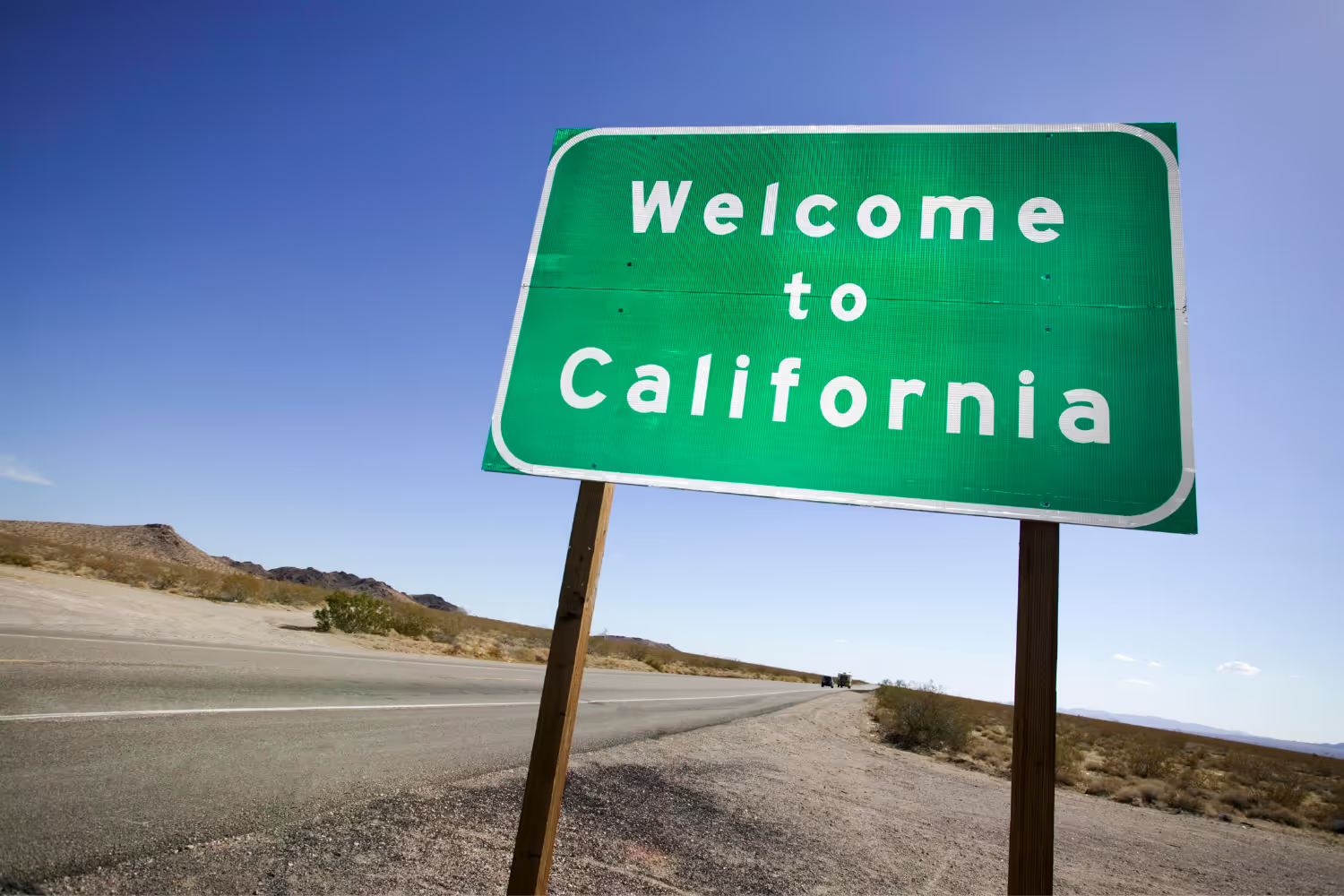
Human trafficking crimes can occur against anyone, no matter their age, gender, or where they’re from. Traffickers treat victims like objects because they only see them as a tool to make money. These criminals have no empathy for the victims’ well-being and health.
Essentially, human trafficking is a crime where the perpetrators profit by forcing vulnerable people into servitude.
California has the 7th highest rate of human trafficking in the United States. In fact, there are about 3.8 trafficking victims in California for every 100,000 civilians. Considering that there are close to 39.54 million people in the state according to the 2020 census, the estimate translates to over 1,500 trafficking victims.
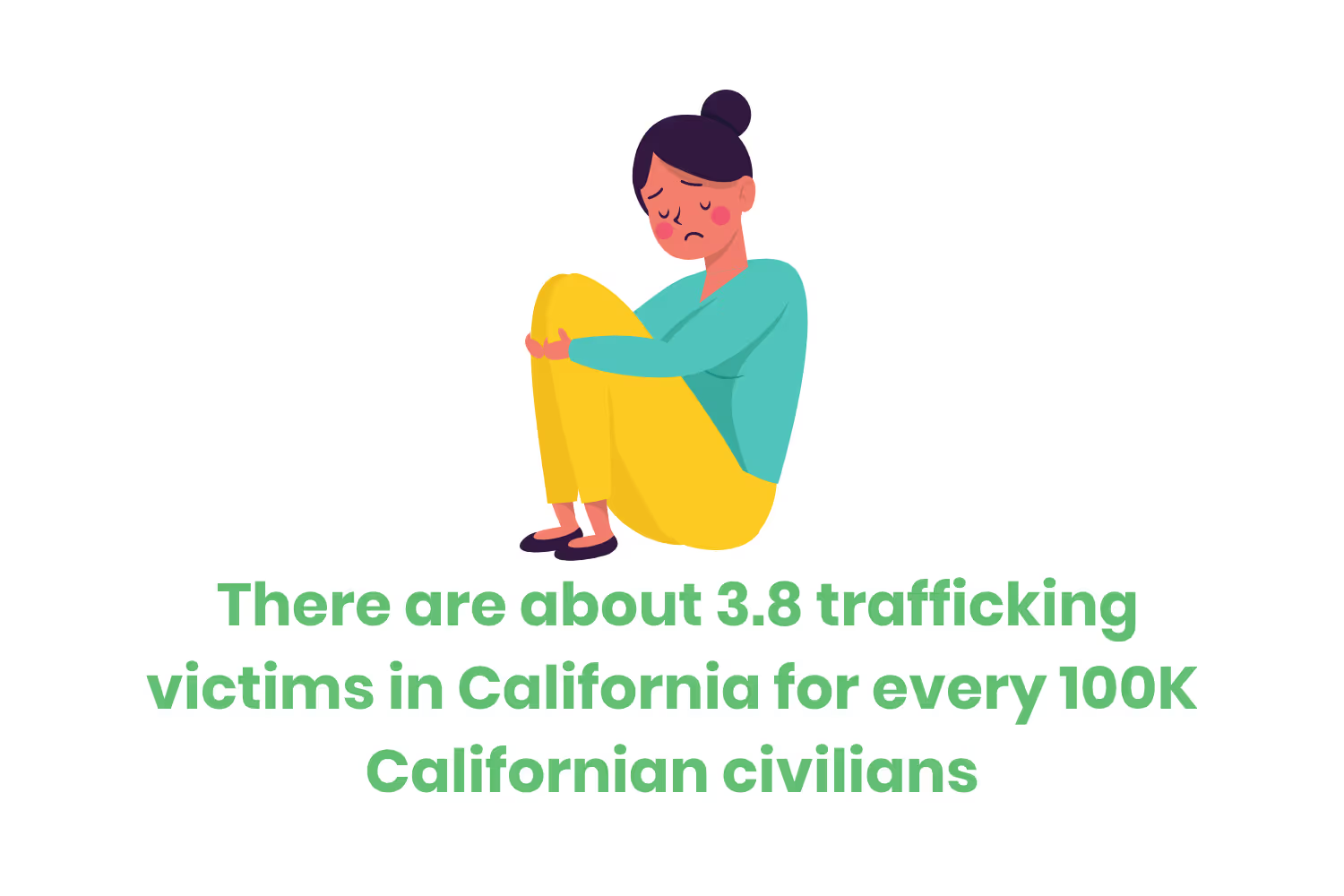
Due to its large and dense population, it’s important to look at how human trafficking occurs in the state. California’s Penal Code 236.1 defines human trafficking as:
- Depriving someone of their freedom to obtain forced labor or services from them;
- Depriving someone of their freedom with the intent of violating California's pimping and pandering laws, child pornography laws, laws against exportation and blackmail, or other laws concerning sexual activity and sexual exploitation of children; OR
- Persuading or attempting to persuade a minor to engage in sexual activity with the intent of violating one of the laws listed above.
Based on the current situation within the state, civilians need to be able to identify potential victims. This then leads to nonprofits and resources aimed at helping victims and reducing rates of this crime.
Once you understand how common this issue is in the state and how civilians can identify the problem to help reduce it, you should also learn about the laws regarding human trafficking. After all, these laws are what lead to punishments for the traffickers so that crime rates can actually decrease.
To help you understand each of these topics better, here are over 50 California human trafficking statistics and laws.
General Statistics
California is the third-largest state geographically and has the largest US population. Its geographical and population sizes contribute to why human trafficking is so problematic. On one hand, it may be easier to hide a victim within a largely populated city. Although, there would also be more people who could identify that something isn’t right. On the other hand, it would be a challenge to locate a victim in rural parts of the state where houses are miles apart.
Because of these different scenarios based on geography, residents need to know where instances could more likely occur. This will help them learn and identify signs of human trafficking based on where they live. That way, they have more understanding of the situation’s seriousness when they go through required training programs.
- Between 2007 and 2020, California experienced… (National Human Trafficking Hotline)
- 40,126 total contacts
- 11,368 total cases
- 12,918 total victims exhibiting a moderate number of human trafficking indicators
- These are cases that contain several indicators that point to human trafficking or resemble common trafficking scenarios.
- However, these cases lack core details of force, fraud, or coercion.
- 9,107 total victims exhibiting a high number of human trafficking indicators
- There are 3.80 human trafficking victims for every 100K Californians. (World Population Review)
- California ranks 7th in the nation with 1507 cases in 2021.
- In comparison, the national average is 2.82 per 100K people.
- The Los Angeles Regional Human Trafficking Task Force’s “Operation Reclaim and Rebuild” ended with 518 arrests and the rescue of 87 victims in 2020. (AP News)
- In 2020, there were three new criminal sex trafficking cases and one sex trafficking conviction in Central California. (Human Trafficking Institute)
- There were one new criminal sex trafficking case, two forced labor convictions, and three sex trafficking convictions in Eastern California. (Human Trafficking Institute)
- There were two new criminal sex trafficking cases and four sex trafficking convictions in Northern California. (Human Trafficking Institute)
- There were three new criminal sex trafficking cases and six sex trafficking convictions in Southern California. (Human Trafficking Institute)
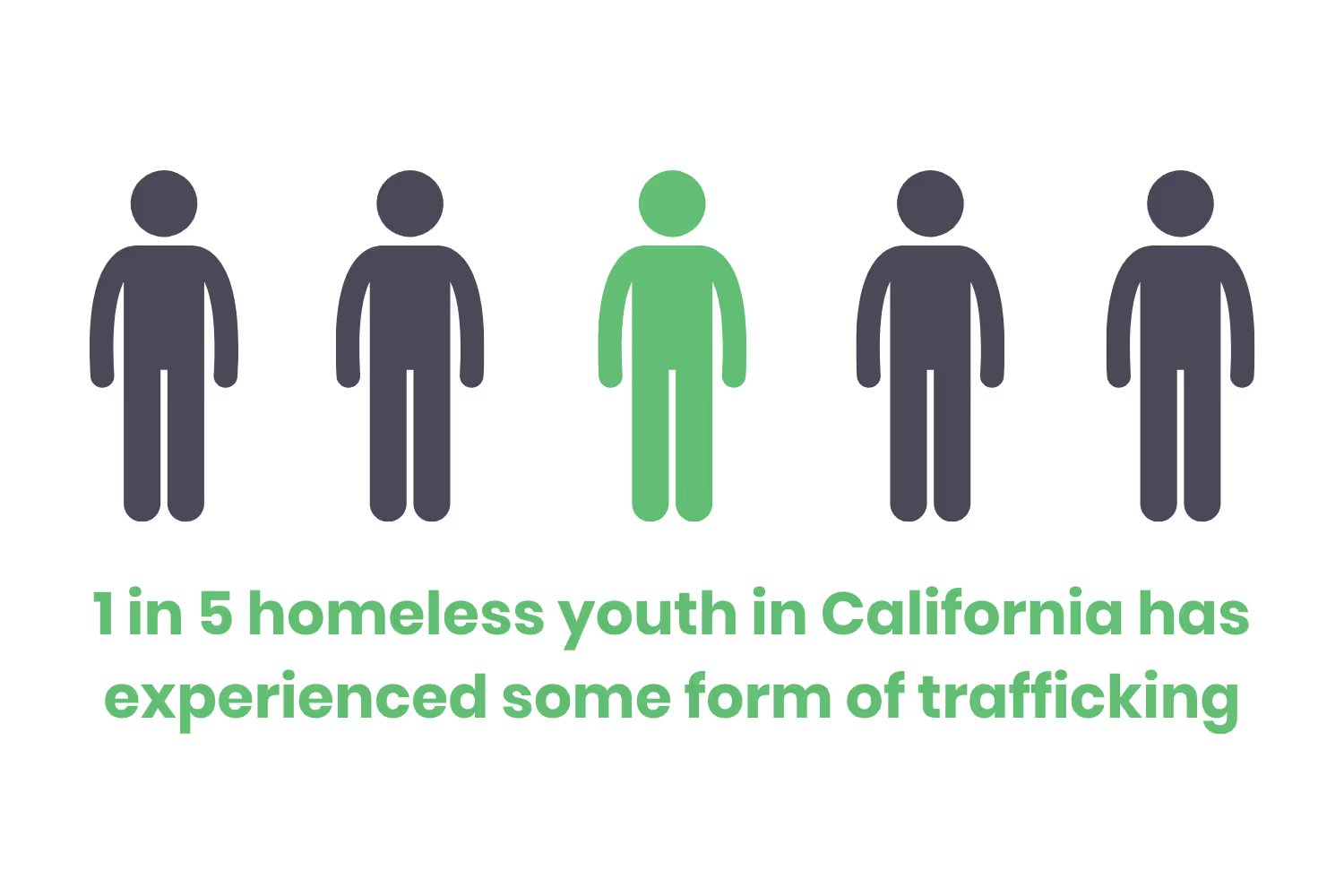
- One of the main points of entry into the US for victims of sex trafficking is Los Angeles. Sex trafficking cases are increasing in San Francisco. (Chest of Hope)
- Almost 1 in 10 homeless individuals in Los Angeles reported being sex or labor trafficked. (Cast)
- 1 in 5 homeless youth in California has experienced some form of trafficking, with 14% experiencing sex trafficking, 8% experiencing labor trafficking, and 3% experiencing forms of both. (Loyola University)
- As of January 1, 2020, California hotel and motel employers must provide a 20-minute human trafficking training to employees once every two years, and within six months of the employee’s hire in that role. (DLA Piper)
Human Trafficking Cases in 2020
(National Human Trafficking Hotline)
2020 was infamous for the start of the COVID-19 pandemic. Despite many states having the no-contact order, California still had 1,334 total reported cases of human trafficking. Now, this wasn’t as bad as previous years, but this is still a larger number of reports.
Workers within some industries may come into contact with human trafficking victims more often, such as those within the hotel and motel industry. Traffickers may use these locations to hide someone, especially as they’re moving them from one location to another. It’s especially important for those working in these industries to know the breakdown of…
- Different types of trafficking
- Victim demographics
- Level of indicators
Understanding these metrics will make it easier for them to identify situations of human trafficking. Below are some statistics of these categories from 2020…
- Type of trafficking
- 129 labor trafficking cases
- 1,025 sex trafficking cases
- 137 unspecified cases
- 43 cases of both sex and labor trafficking
- Age
- 904 adults
- 268 minors

- Gender
- 1,106 female victims
- 155 male victims
- 15 gender minority victims
- There were 4,970 total contacts to the National Human Trafficking Hotline.
- 1,574 total victims exhibited a moderate level of indicators.
- These are cases that contain several indicators that point to human trafficking or resemble common trafficking scenarios.
- However, these cases lack core details of force, fraud, or coercion.
- 519 total victims exhibited a high level of indicators.
Legal Cases in 2020
Just because there were over 1,000 reports of human trafficking doesn’t mean that law enforcement was able to act upon or apprehend each perpetrator.
With that said, there were many court cases involving people accused of human trafficking. The statistics below paint a picture of legal cases and their results in 2020.
- 100% of new defendants were in court due to sex trafficking accusations.
- There are 12 such defendants.
- There were 95 active defendants.
- 21% of the cases involved the accusation of forced labor.
- 79% of the cases involved the accusation of sex trafficking.
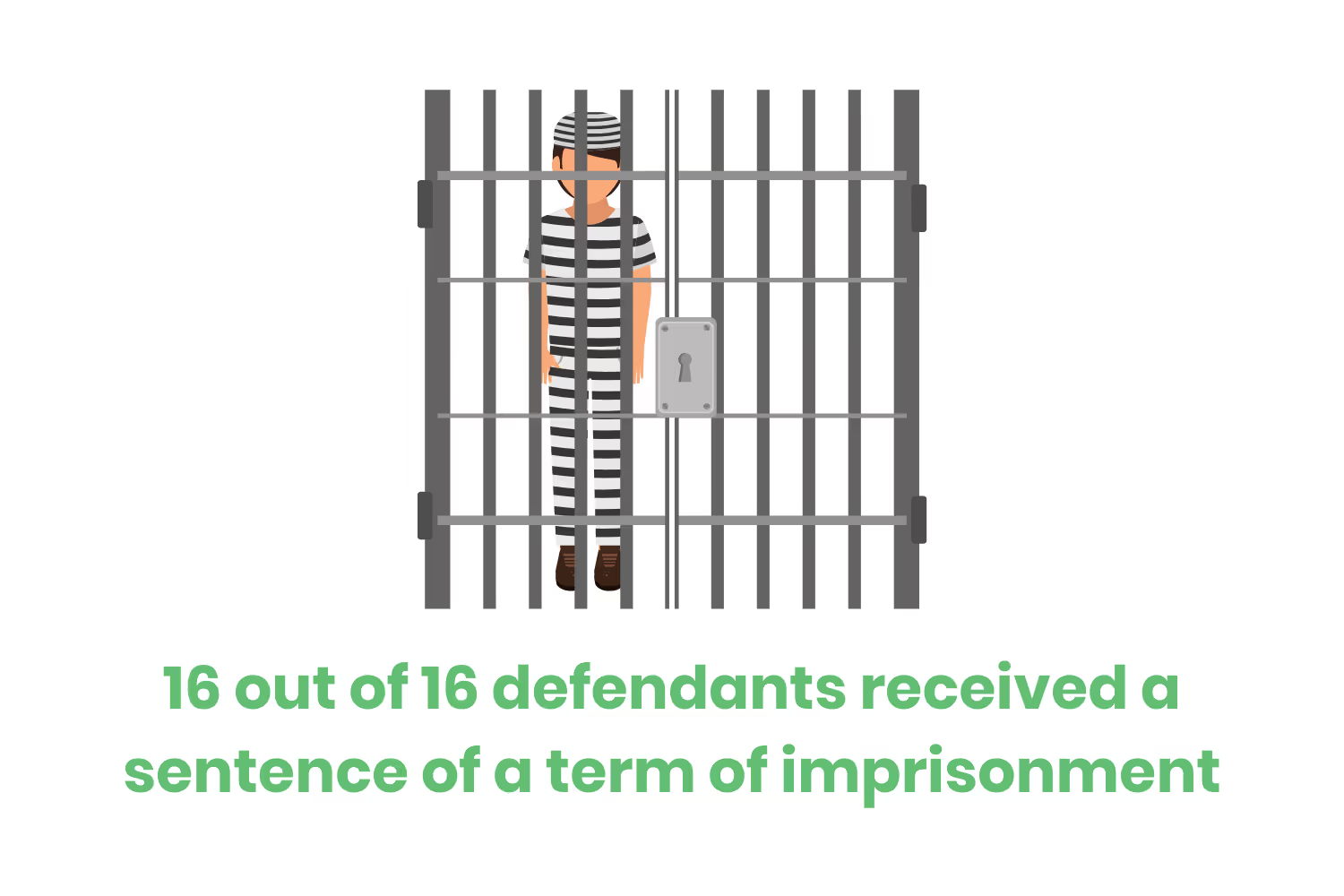
- The trial court resolved 16 of 21 cases.
- 16 out of 16 defendants received a sentence of a term of imprisonment.
- Forced labor convictions made up 12% of the sentences.
- Sex trafficking convictions made up 88% of the sentences.
- The average sentence was 113 months in prison.
- 3 of the convicted defendants were in cases where a victim was not named. Therefore, out of 13 cases with named victims, the judge ordered 6 of them to pay restitution to the victim.
- 16 out of 16 defendants received a sentence of a term of imprisonment.
Contacts in 2020
(National Human Trafficking Hotline)
There were 4,970 total contacts in 2020 alone, as mentioned in the statistics above. In this context, contact means someone reaching out to the National Human Trafficking Hotline. This includes phone calls, texts, online chats, emails, or webforms.
But the actual people behind these contacts can vary. Sometimes it's the actual victim contacting the hotline. Other times, it's a community member who witnessed something that concerned them.
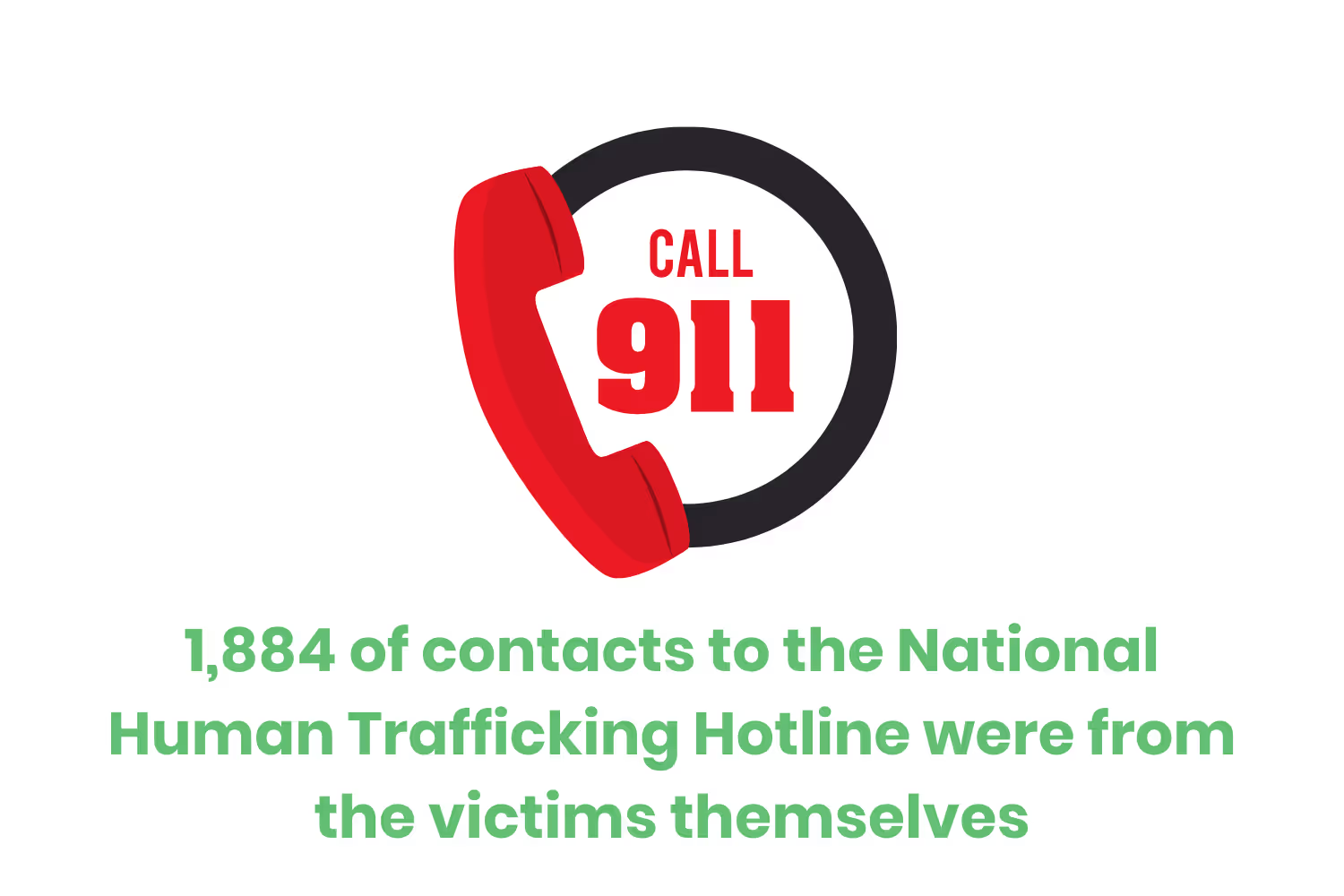
Below is the statistical breakdown of all the people who contacted the National Human Trafficking Hotline in 2020.
- 1,884 victims themselves
- 830 concerned community members
- 501 victims of another crime seeking help
- 394 NGO representatives
- 452 other contacts
Labor Trafficking Hotspots in 2020
(National Human Trafficking Hotline)
There are two definitions of labor trafficking that affect Californians. The first definition comes from the federal government while the second comes from California's Penal Code.
The federal government defines labor trafficking as…
- “The recruitment, harboring, transportation, provision, or obtaining of a person for labor or services, through the use of force, fraud, or coercion for the purpose of subjection to involuntary servitude, peonage, debt bondage, or slavery.”
California’s Penal Code, Section 236.1, defines forced labor services as…
- “Labor or services performed or provided by a person obtained or maintained through force, fraud, duress, or coercion, or equivalent conduct that would reasonably overbear the will of the person.”
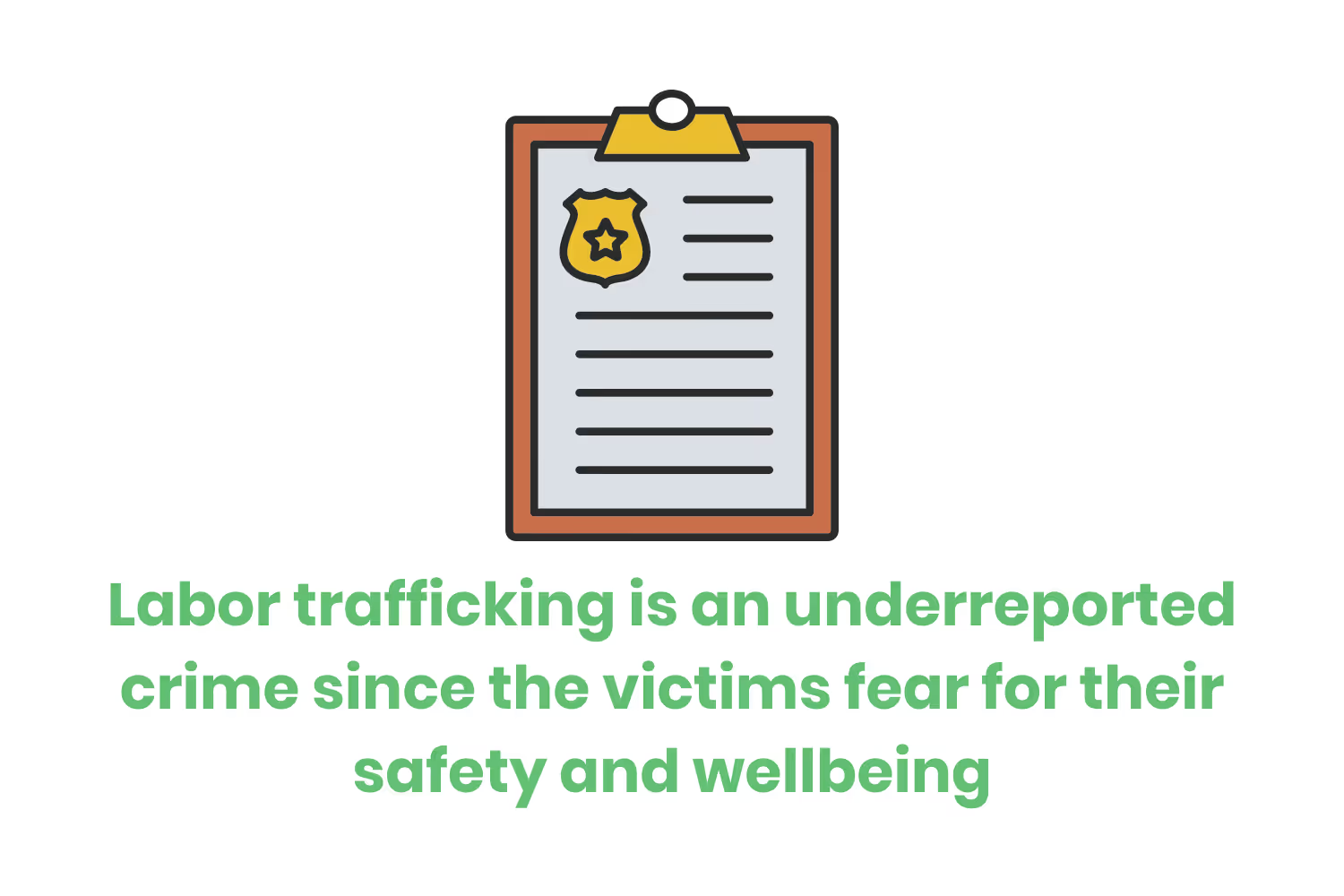
Despite these slightly different definitions, one thing remains clear: labor trafficking can occur anywhere. But you already know that since we went over different geographical areas earlier.
It tends to be an underreported crime since the victims fear for their safety and wellbeing. Some industries make it easier to hide labor trafficking, such as
- Agriculture
- Construction
- Domestic work
- Factories
- Healthcare
- Manufacturing
In California specifically, below are some of the most common industries hiding victims…
- 34 cases in the domestic work industry
- 14 cases in the agricultural industry
- 8 cases were part of traveling sales crews
- 6 cases in the retail space or other small businesses
- 4 cases were in begging rings (sales crews/peddlers such as solicitors)
Sex Trafficking Hotspots in 2020
(National Human Trafficking Hotline)
California uses the federal definition of sex trafficking in its Penal Code. The federal definition of sex trafficking is when…
- “A commercial sex act is induced by force, fraud, or coercion, or in which the person induced to perform such act has not attained 18 years of age.”
Part two of the definition says that it involves “the recruitment, harboring, transportation, provision, or obtaining of a person for labor or services, through the use of force, fraud, or coercion for the purpose of subjection to involuntary servitude, peonage, debt bondage, or slavery.”
Unfortunately, victims of sex trafficking vary in age, ethnicity, and national origin. Many domestic victims are runaways and come from a background of abuse, poverty, and addiction. Traffickers exploit these vulnerable people for their own benefit.
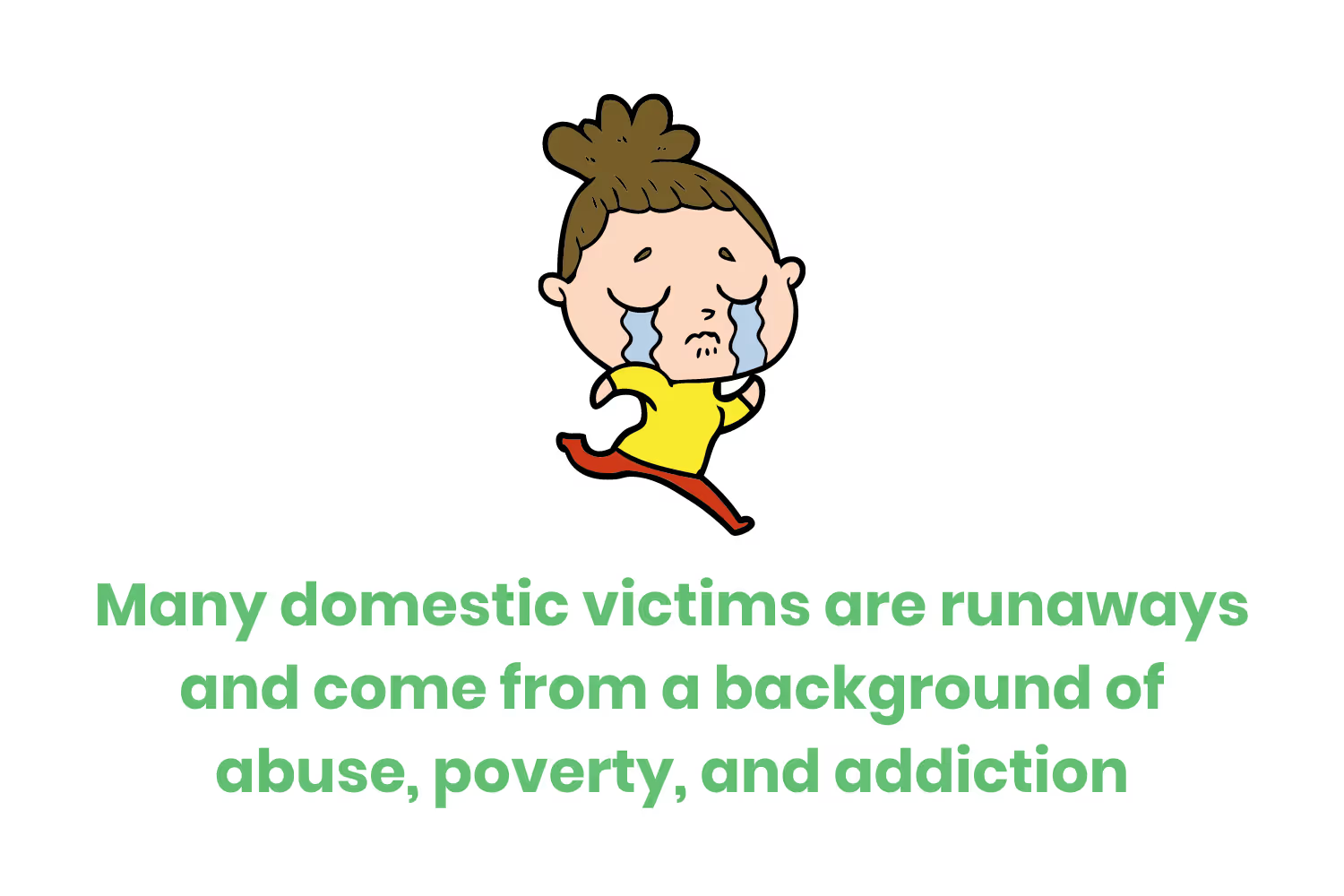
Despite the wide range of victim profiles, there are common industries that harbor sex trafficking rings. In California, below are the five most common industries that hid this type of illegal activity.
- 97 cases were in illicit massage or spa businesses
- 88 cases were part of the pornography industry
- 71 cases were in hotel-motel based businesses
- 58 cases occurred in residence-based commercial sex venues
- 47 cases were in other venues
Laws and Regulations
As you can see, California has a relatively high rate of human trafficking. Understanding the current situation is the first step in mitigating the situation.
The next step is familiarizing yourself with the state’s laws and regulations. There are three main categories of these laws.
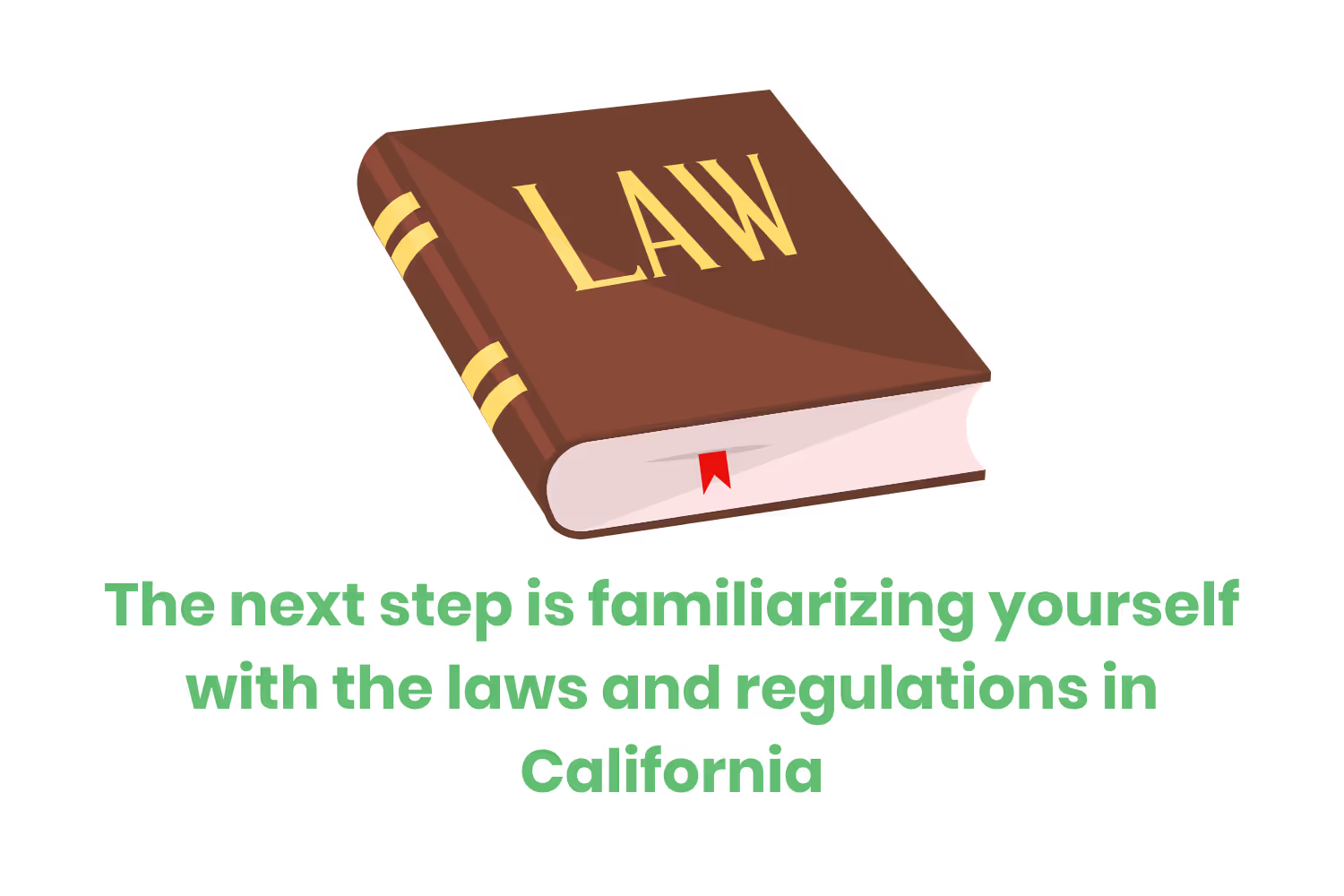
The first involves mandatory training. This includes the topics the training needs to cover, the length of training, which industries must implement it, and what kind of employees need to take it.
The second category has to do with the posting of a model notice. There have been many laws updating and changing the model notice over the years. Some updates are regarding the physical location of the notice in a facility and which types of industries need to post it.
The third law, which I’ve already mentioned a few times, is the California Penal Code. You should know all of the different punishments that perpetrators can face. Most convicted traffickers will experience jail time and fines in addition to having to register as sex offenders.
Mandatory Training
In 2018, Assembly Bill 2034 went into effect. This bill requires specific businesses or establishments such as airports, bus stations, or truck stops to provide human trafficking training.
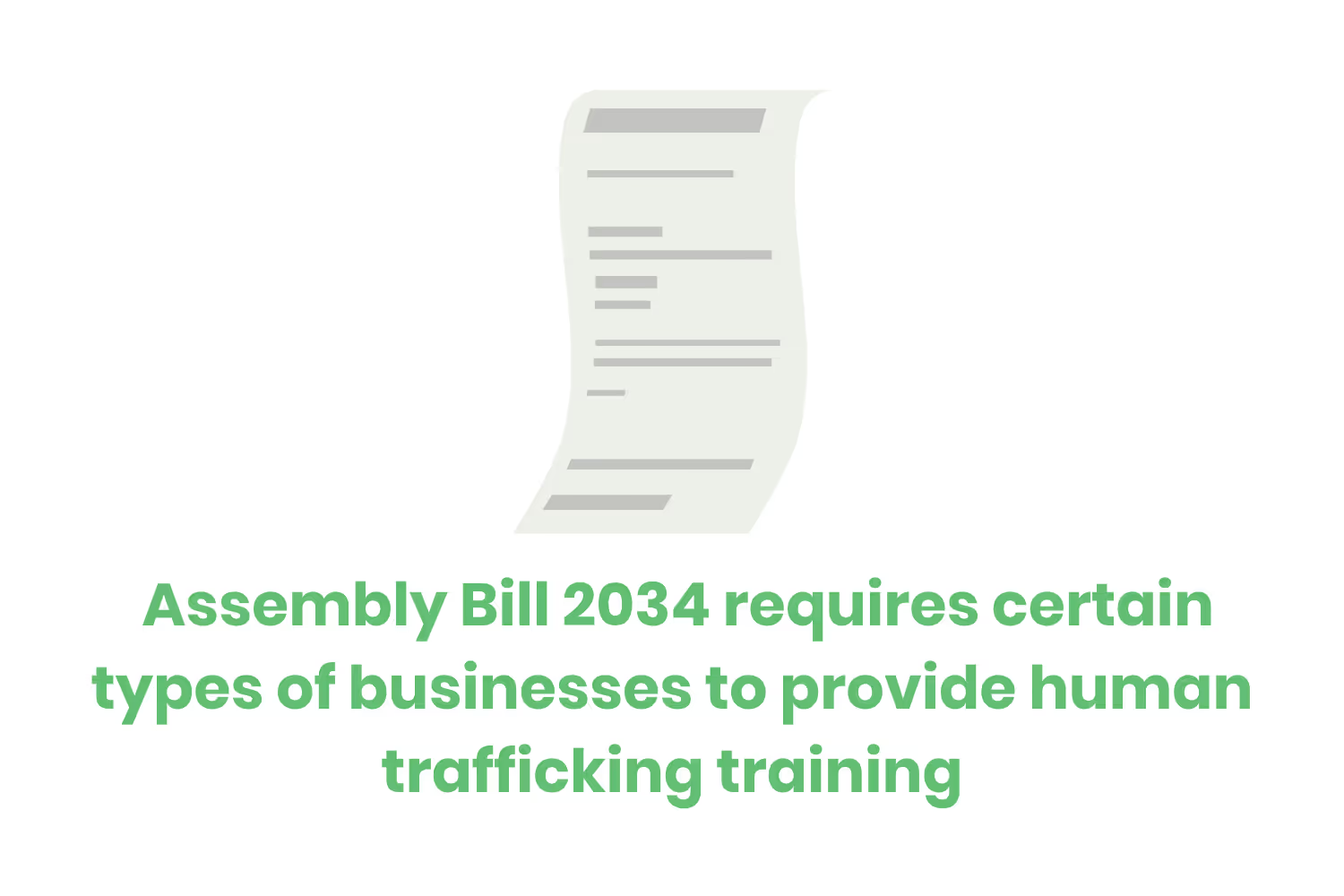
Employers need to give this training to new and existing employees that could interact with or come in contact with a victim of human trafficking. It also applies to employees who are likely to receive a report from another employee about suspected human trafficking.
The bill requires these employees to complete at least 20 minutes of training. The topics of the training include…
- The definition of human trafficking, sex trafficking, and labor trafficking
- Myths and misconceptions about human trafficking
- Physical and mental signs that may indicate someone is a victim of human trafficking
- Guidance on how to identify people most at risk of trafficking
- Guidance on how to report human trafficking
- Protocols for reporting human trafficking when working
This bill also requires local government agencies to perform additional duties. Therefore, the bill would impose a state-mandated local program.
Posting Model Notice
In 2013, California enacted Senate Bill 1193, adding section 52.6 to the California Civil Code. This code mandates that specific types of businesses and establishments post a human trafficking model notice created by the Attorney General’s Office.
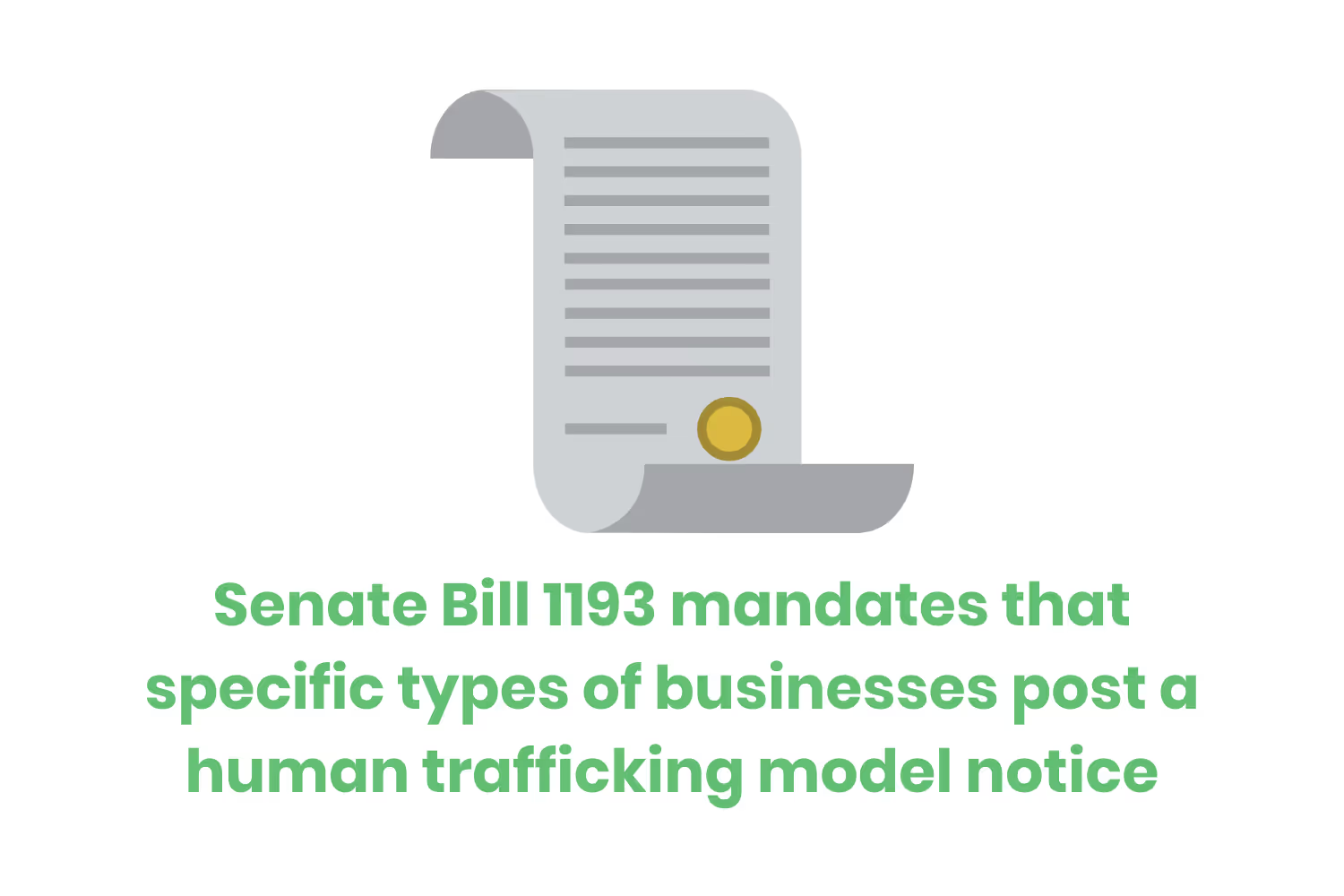
Such places include, but are not limited to…
- Primary airports
- Bus stations
- Truck stops
- Emergency rooms
- Form labor contractors
- Privately operated job recruitment centers
- Roadside rest areas
- Urgent care centers
These establishments need to post the notice in a clearly visible place near their public entrance. The notice can also be in any public place where the business posts other notices. It must be in English, Spanish, and in one other language that is the most widely spoken in the county.
If a business fails to comply, it can face a fine of $500 for a first offense and $1000 for each offense after that.
Senate Bill 1193 required that the notice state the following…
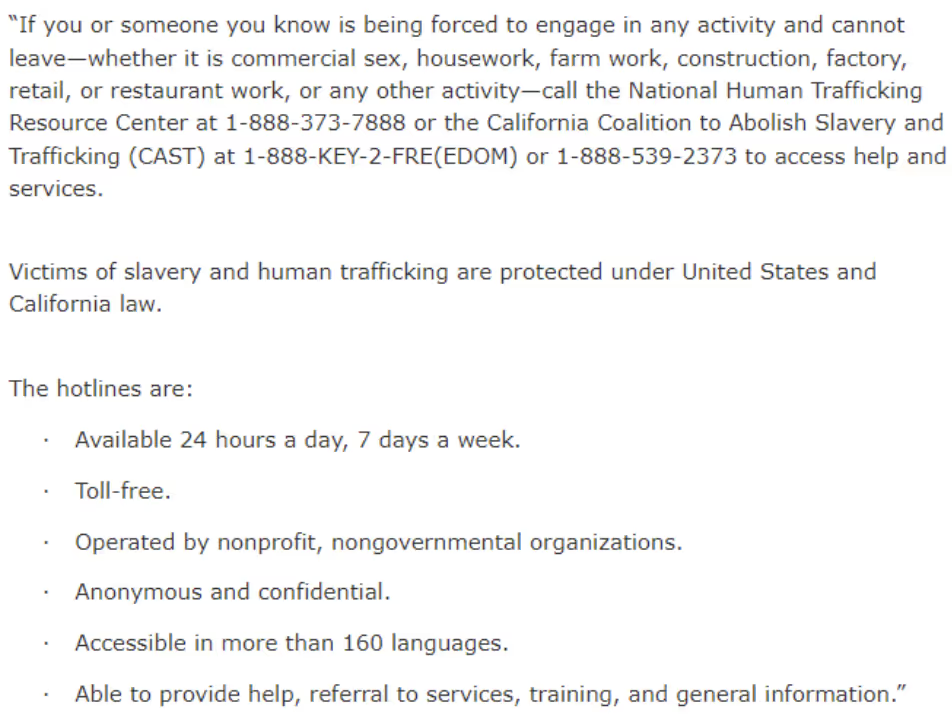
In 2017, California enacted Senate Bill 225 and Assembly Bill 260.
This Senate bill requires that the notice also include the option for someone to text a specified number for services and support. Any business or establishment required to post the model notice would need to update it with this change in language…
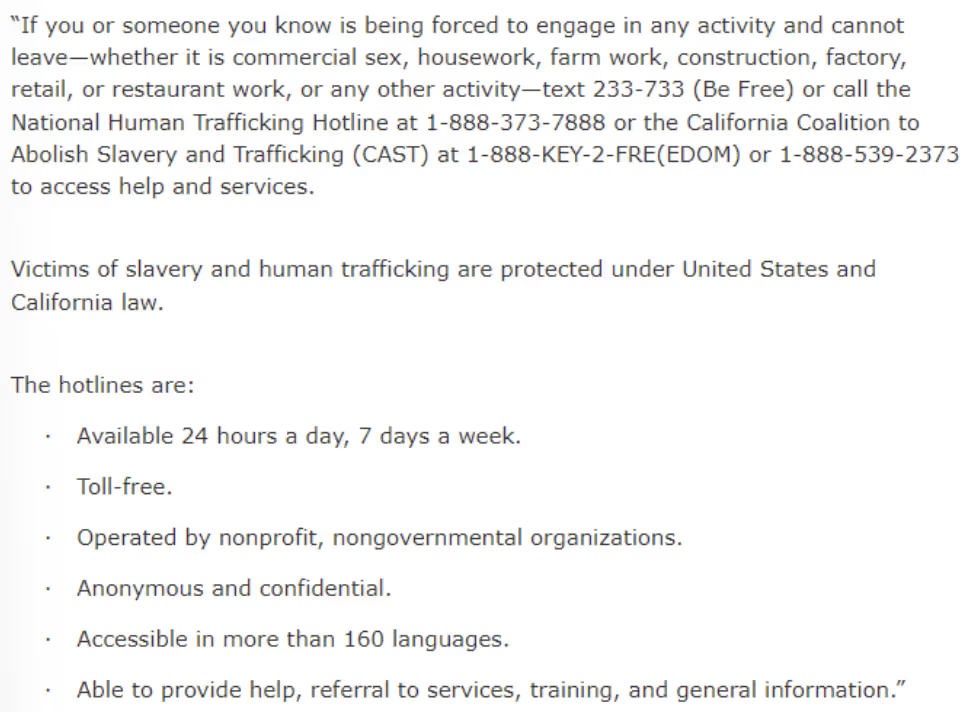
The Assembly bill would add hotels, motels, and bed-and-breakfast to the list of businesses that would need to post the notice. However, the additional establishments do not include personal residences.
In 2019, Senate Bill 630 provided clarity on the role of local governments in adopting and enforcing rules at a local level to combat human trafficking. More specifically, the bill states that existing provisions regarding non-compliance don’t prevent a local governing body from adopting and enforcing local laws and regulations to prevent human trafficking. It also specifies that the penalties do not supersede or preempt that local ordinance, rule, or regulation.
Punishments
Penal Code 236.1 addresses the punishments for trafficking people in California. Any form of trafficking people is a felony.
Someone can face the following if convicted of labor trafficking:
- Formal (felony) probation
- 5, 8, or 12 years in California state prison, and
- A fine of up to $500,000 years
If convicted of sex trafficking, child pornography, or extortion, that person faces…
- Formal (felony) probation
- 8, 14, or 20 years in state prison,
- A fine of up to $500,000, and
- Requirement to register for life as a three-tier sex offender
If someone persuades a minor to engage in a commercial sex act, they can face…
- Formal (felony) probation
- 5 to 12 years in prison, OR 15 years to life in prison if the jury determines that the defendant used force, fear, violence, or threat of injury to the alleged victim,
- A $500,000 fine, and
- Requirement to register as a sex offender for life
Someone could face an additional consecutive 5, 7, or 10 years in prison if the jury finds them guilty of inflicting great bodily injury to the victim while committing the trafficking offense. A previous human trafficking violation can lengthen the sentence. They could face an additional 5 years of prison for each prior violation.
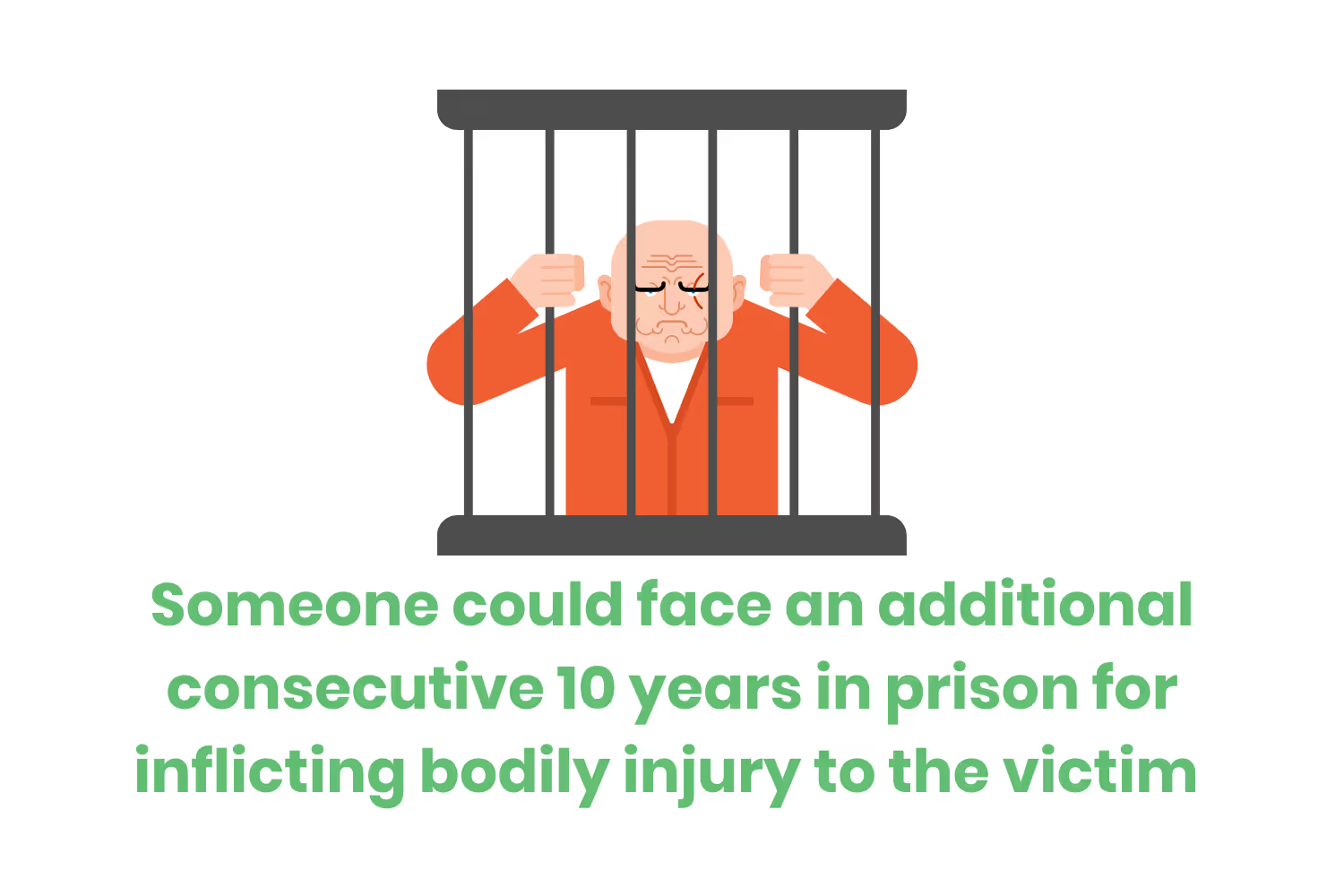
The judge can decide to impose an additional fine up to $1,000,000 depending on the…
- Seriousness of the offense
- Circumstances
- Duration of the offense
- Benefits the defendant derived from trafficking the alleged victim
- Extent of suffering the victim endured
The victim can also bring a civil lawsuit against the trafficker for damages related to the trafficking. The court has wide discretion to impose civil penalties under California law. This includes amounts up to three times the damages the victim is able to show.
If a sex trafficking victim is under the age of 18, the trafficker can face different types of asset forfeiture. This includes any property (including vehicles, real estate, and money) used in the trafficking case. It could also include any property acquired with the proceeds of the trafficking.
Conclusion
Despite the ratio of human trafficking victims to state residents, California has a large number of active trafficking situations. In fact, it has the seventh-highest rate of all states in the country. Trafficking can impact anyone, no matter their demographic. However, some industries have higher rates based on the nature of the work or venue environment.
Because of the alarming California human trafficking statistics, the state is making efforts to improve the situation. One of these ways is through expanding mandatory training for employees that may come in contact with trafficked victims. This makes it easier for civilians to identify and report when there’s an incident.
Since it’s so important for people to recognize these situations, there are state laws that require businesses to provide training and post human trafficking notices. All of these proactive measures make it easier for law enforcement to catch and convict traffickers, especially when Californians can report them.
Sources
Emphasize your product's unique features or benefits to differentiate it from competitors
In nec dictum adipiscing pharetra enim etiam scelerisque dolor purus ipsum egestas cursus vulputate arcu egestas ut eu sed mollis consectetur mattis pharetra curabitur et maecenas in mattis fames consectetur ipsum quis risus mauris aliquam ornare nisl purus at ipsum nulla accumsan consectetur vestibulum suspendisse aliquam condimentum scelerisque lacinia pellentesque vestibulum condimentum turpis ligula pharetra dictum sapien facilisis sapien at sagittis et cursus congue.
- Pharetra curabitur et maecenas in mattis fames consectetur ipsum quis risus.
- Justo urna nisi auctor consequat consectetur dolor lectus blandit.
- Eget egestas volutpat lacinia vestibulum vitae mattis hendrerit.
- Ornare elit odio tellus orci bibendum dictum id sem congue enim amet diam.
Incorporate statistics or specific numbers to highlight the effectiveness or popularity of your offering
Convallis pellentesque ullamcorper sapien sed tristique fermentum proin amet quam tincidunt feugiat vitae neque quisque odio ut pellentesque ac mauris eget lectus. Pretium arcu turpis lacus sapien sit at eu sapien duis magna nunc nibh nam non ut nibh ultrices ultrices elementum egestas enim nisl sed cursus pellentesque sit dignissim enim euismod sit et convallis sed pelis viverra quam at nisl sit pharetra enim nisl nec vestibulum posuere in volutpat sed blandit neque risus.

Use time-sensitive language to encourage immediate action, such as "Limited Time Offer
Feugiat vitae neque quisque odio ut pellentesque ac mauris eget lectus. Pretium arcu turpis lacus sapien sit at eu sapien duis magna nunc nibh nam non ut nibh ultrices ultrices elementum egestas enim nisl sed cursus pellentesque sit dignissim enim euismod sit et convallis sed pelis viverra quam at nisl sit pharetra enim nisl nec vestibulum posuere in volutpat sed blandit neque risus.
- Pharetra curabitur et maecenas in mattis fames consectetur ipsum quis risus.
- Justo urna nisi auctor consequat consectetur dolor lectus blandit.
- Eget egestas volutpat lacinia vestibulum vitae mattis hendrerit.
- Ornare elit odio tellus orci bibendum dictum id sem congue enim amet diam.
Address customer pain points directly by showing how your product solves their problems
Feugiat vitae neque quisque odio ut pellentesque ac mauris eget lectus. Pretium arcu turpis lacus sapien sit at eu sapien duis magna nunc nibh nam non ut nibh ultrices ultrices elementum egestas enim nisl sed cursus pellentesque sit dignissim enim euismod sit et convallis sed pelis viverra quam at nisl sit pharetra enim nisl nec vestibulum posuere in volutpat sed blandit neque risus.
Vel etiam vel amet aenean eget in habitasse nunc duis tellus sem turpis risus aliquam ac volutpat tellus eu faucibus ullamcorper.
Tailor titles to your ideal customer segment using phrases like "Designed for Busy Professionals
Sed pretium id nibh id sit felis vitae volutpat volutpat adipiscing at sodales neque lectus mi phasellus commodo at elit suspendisse ornare faucibus lectus purus viverra in nec aliquet commodo et sed sed nisi tempor mi pellentesque arcu viverra pretium duis enim vulputate dignissim etiam ultrices vitae neque urna proin nibh diam turpis augue lacus.




